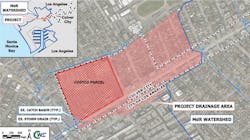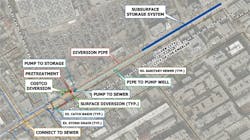City partners with Costco for stormwater capture, diversion, saving 30 percent of costs
As cities and municipalities struggle to comply with mandates to address stormwater quality and treatment, alternative funding mechanisms become even more critical. Public-private partnerships (P3), especially for regional water quality projects, can provide untold benefits to the local community while saving the utility and taxpayers money.
Culver City’s Washington Boulevard Stormwater and Urban Runoff Diversion Project is a unique P3 for stormwater management between the city and warehouse-club store Costco. The project addresses discharges from the city within the Marina del Rey Watershed, and redevelopment and expansion of Costco’s parking lot.
The Washington Boulevard Stormwater and Urban Runoff Project is located adjacent to a large Costco store and runs along Washington Boulevard from Lincoln Avenue to the west (within the City of Los Angeles), and Redwood Avenue (Culver City) to the east. Courtesy CWE Engineering.
Background
Culver City comprises a nearly 5-square-mile area in Los Angeles County, Calif. While mostly surrounded by the city of Los Angeles, Culver City also shares a border with some unincorporated areas of L.A. County. Additionally, 42 acres of the city’s jurisdiction exists within 1,409 acres of the Marina del Rey Watershed.
A Costco warehouse store exists on the largest parcel within city limits in the Marina del Rey Watershed, at the westernmost edge of the city. When a neighboring grocery store closed down, Costco sought to demolish the building and expand to increase the size of its parking lot. The planned redevelopment triggered requirements under Los Angeles County’s Municipal Separate Storm Sewer System (MS4) permit specifying that water quality components be included in new construction.
At the same time, the city had been looking for its own MS4 projects to comply with the Marina del Rey Enhanced Watershed Management Program (EWMP).
“[The project] was the result of a mutual need between the city and Costco,” Lee Torres, senior civil engineer with Culver City, said.
The Project
In order to reduce the flow of pollutants into the Marina del Rey Harbor, the project will capture stormwater and urban runoff before it enters the storm drain system and store it in an underground sealed storage tank.
The project includes several surface diversions and a diversion off of Costco’s storm drain. Those diversions redirect the runoff that’s normally on the streets or in the parking lot, screen for particles, trash or other debris, and send it to an underground storage tank capable of holding about three acre-feet of water.
“The storage tank underneath Washington Boulevard runs about 700 linear feet along Washington Boulevard,” Katie Harrel, special projects manager with CWE, an engineering firm that worked on the project, said. “The water is stored for a few days after the rain and then it gets slowly discharged back to the sewer system and to the City of Los Angeles’s Hyperion treatment plant.”
Some of the captured water will also be used to water plants in new street medians once the project is complete.
“The reason we chose this best management practice (BMP) is that we have high groundwater levels in that area of the city and poor soil conditions that don’t allow us to infiltrate through the ground, so this was the most feasible BMP for the area,” Torres said.
An overview of the Washington Boulevard Stormwater and Urban Runoff Project shows the components of the project. Courtesy CWE Engineering.
Cost Savings and Traffic Mitigation
Costco will be responsible for $2,140,000 of the $8 million final cost, the same amount they would have paid to complete the project on their own if they had not partnered with the city.
“We worked together to develop a memorandum of understanding (MOU) so that Costco could address what it wanted and the city could address what we needed as well,” Torres said of the process. “We wanted to make sure that this was cost-shared properly, so we looked at the cost for Costco to complete construction on its own, and it paid that portion of the project, which took our cost down significantly.”
While Costco has allowed the city to use its land area for some construction, most of the installation will be completed below the roadways in front of the store, where approximately 2,500 vehicles travel in two lanes going in either direction during the peak hour each day.
“The city will be losing about 800 feet of parking during construction, and [there will be] one lane of travel open toward the west and two lanes toward the east, taking away about 36 feet of width from the existing travel way during construction,” Harrel said. “So, there will definitely be an impact and a lot of restricted turning movements.”
“The cost [of construction] has gone up a little bit because of where we’re building, it being on the street, and there is a lot of traffic control,” Torres acknowledged.
Simulations showed some backup in traffic but using various methods of traffic alleviation will help lessen those impacts, Harrel added. Traffic control message signs will be placed for several miles before the project to try to encourage commuters to go with an alternative route, and local media will disseminate information prior to major construction. Costco has even offered to use its own social media channels to alert its customers about other options for grocery shopping, including delivery services and buy-online-pick-up-in-store options, with delivery and packing fees waived.
“Costco has continued to partner with us because of the MOU, and is working with us on the coordination of everything [as we go],” Torres said.
And while the city gets to complete projects for its Enhanced Watershed Management Program at a lower price point, Costco benefits too.
“The benefit for Costco is that it’s not overseeing the BMP project for repairs it would have completed anyway, and then it’s not responsible for having those types of facilities on its property,” Harrel said. “Costco is basically able to just pay an annual fee to the city and the city will maintain [the BMP] in perpetuity (as the owners of it). I think it creates a good working relationship with the city.”
The city is currently on track for the final project to be completed by 2020. WW
About the Author: Alanna Maya is the assistant editor for WaterWorld magazine. Reach her at [email protected].
Circle No. 245 on Reader Service Card
About the Author

Alanna Maya
Chief Editor
Alanna Maya is a San Diego State University graduate with more than 15 years of experience writing and editing for national publications. She was Chief Editor for WaterWorld magazine, overseeing editorial, web and video content for the flagship publication of Endeavor's Water Group. In addition, she was responsible for Stormwater magazine and the StormCon conference.


